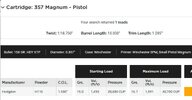I did a through cleaning of the cylinder. I followed the instructions of Bore Tech. They say first get the barrel (or cylinder) wet with Bore Tech Eliminator. Then use an undersized brush with a patch wrapped around it with Bore Tech Chameleon Gel. This gets the cylinder (or barrel) wet with Chameleon Gel. Let it set for 3 to 5 minutes.
Next followed the instructions of
eddiememphis and
Rule3 I used a 357 brass case. I flared the mouth with a 38 special/357 expanding die. I expanded it a little at a time until it was just the right size to tightly fit into the cylinder. Pushing this expanded 357 brass case into each chamber of the cylinder scraped them out nicely.
Then I used Bore Tech Eliminator again to clean out any residue.
I'm going to be honest here and say I really don't think this will be the final fix of my problem. I did not see my crud ring as being of an issue that can explain the stuck brass. Sure there was a crud ring but I don't think this was enough to cause my stuck brass.
Did you buy your Ruger new or used? How long has the “crud ring” been in the chambers of the cylinder?
I may eat my words and agree with W.E.G. who said
"I have ANOTHER 686. I won't shoot .38 in it. Not. Even. Once."
He wants to keep 357 magnum completely separate from 38 Special.
Are Crud rings that bad that you must separate 357 onto a separate gun from the 38 Special?
I do, and if I do shoot a few .38’s in one of my .357’s, I clean it thoroughly right after, using one of the stainless tornado brushes on the cylinder. The longer the “crud ring” stays in there, and the more you add to it over time, the more likely you are to have extraction problems with the longer .357 cases and the more difficult it will be to remove said rings.
I'll shoot my newly cleaned Blackhawk through a chronograph in the next few days. I need to make sure the weather is good.





